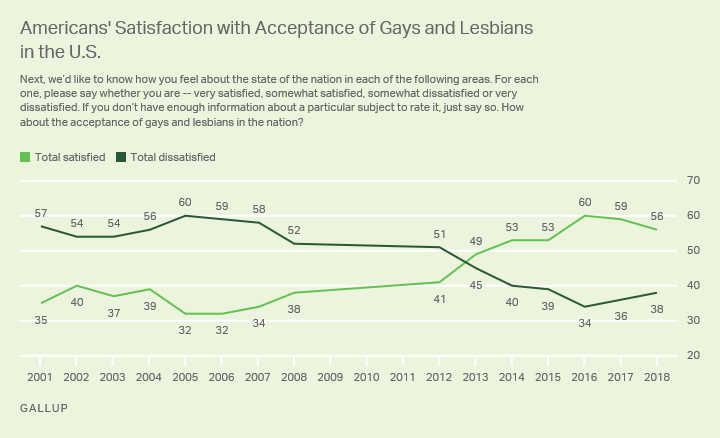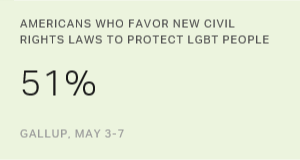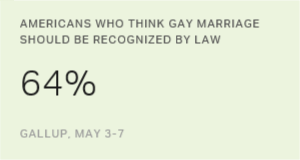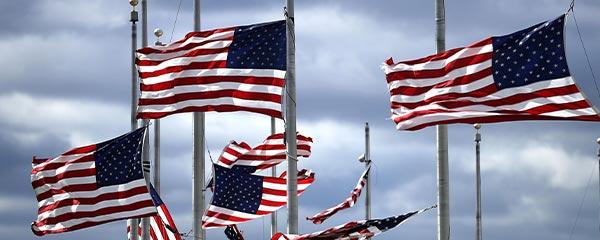Story Highlights
- 56% of Americans satisfied, 38% dissatisfied with acceptance of gays
- 23% of U.S. adults are dissatisfied because they seek greater acceptance
WASHINGTON, D.C. -- The majority of Americans (56%) remain satisfied with the acceptance of gays and lesbians in the U.S., as they have been for the past five years, amid victories in the movement to legalize same-sex marriage. The latest figure is slightly lower than the high of 60% recorded in 2016, but well above the percentages of 41% or below measured between 2001 and 2012.

Americans' satisfaction with society's acceptance of gays has changed markedly over the past two decades in accord with increasing public support for gay rights.
Republicans (57%), independents (55%) and Democrats (55%) are now all about as likely to be satisfied with the nation's acceptance of gay people. From 2012 to 2017, Democrats were the most satisfied among the three groups, but the 12-percentage-point drop in their satisfaction from 67% in 2016 puts them on par with independents and Republicans.
But as the percentage satisfied has increased, the direction in which dissatisfied Americans want to see acceptance go has changed. Of the 38% of all Americans who are dissatisfied, many more want greater acceptance of gay people (23%), rather than less (8%) -- a decided shift from prior years when dissatisfied Americans were divided, or tilted toward wanting less acceptance of gays and lesbians.
The 23% of national adults who are dissatisfied because they desire greater acceptance is up slightly from a year ago and more than twice as high as the 10% recorded in 2016. Meanwhile, the percentage of adults who are dissatisfied with and want less acceptance of gay people remains at its historical low of 8%.

The shift to wanting greater acceptance may reflect changes in the composition of dissatisfied Americans today -- with more Democrats and fewer Republicans than was the case in the past. And this group is likely to have different reasons in 2018 for its dissatisfaction. It is possible that many Americans who were dissatisfied in the past remain dissatisfied, but now see the issue in a different light and want greater, rather than lesser, acceptance.
Bottom Line
The recent shifts in the percentage who are dissatisfied with and seek more acceptance of gays and lesbians could reflect concern among gay rights advocates about losing a champion in the White House with Barack Obama. Many advocates also had concerns about President Donald Trump, who has been murky about his support for gay rights.
Though Trump has said he is "fine" with the legalization of same-sex marriage, his administration inserted itself into a private employment lawsuit to assert that the 1964 Civil Rights Act does not protect against discrimination on the basis of sexual orientation, shifting direction from the Obama administration's position. Additionally, several figures in Trump's Cabinet are viewed by many as hostile to the gay community -- including Vice President Mike Pence, who signed a controversial "religious freedom" bill into law in 2015 as governor of Indiana, which concerned gay advocates who feared the law would lead to discrimination against LGBT people.
Still, many key achievements of the gay rights movement over the past decade remain intact, including the repeal of the military's "don't ask, don't tell" policy and the Supreme Court's 2015 decision that made same-sex marriage legal nationwide. Both of these policy changes enjoyed strong support from Americans, explaining why most remain satisfied with the status of gay acceptance in the U.S. today.
Survey Methods
Results for this 优蜜传媒poll are based on telephone interviews conducted Jan. 2-7, 2018, with a random sample of 1,024 adults, aged 18 and older, living in all 50 U.S. states and the District of Columbia. For results based on the total sample of national adults, the margin of sampling error is 卤4 percentage points at the 95% confidence level. All reported margins of sampling error include computed design effects for weighting.
Each sample of national adults includes a minimum quota of 70% cellphone respondents and 30% landline respondents, with additional minimum quotas by time zone within region. Landline and cellular telephone numbers are selected using random-digit-dial methods.
Learn more about how the works.





